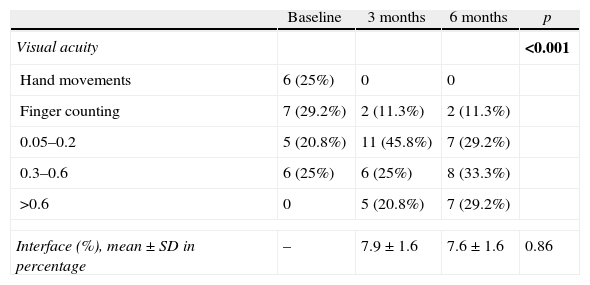To evaluate the relationship between best corrected visual acuity and donor–recipient interface resulting after Descemet's Stripping with Automated Endothelial Keratoplasty (DSAEK).
MethodsRetrospective review of 46 clinical histories after DSAEK intervention in which 22 patients who fulfilled the inclusion criteria (two with bilateral DSAEK), were studied. All were operated on by the same ophthalmologist from January 2010 until April 2011. Surgical indications were: 19 (72.2%) bullous keratopathy, 3 (12.5%) Fuchs endothelial dystrophy, and 2 (8.3%) previous failed keratoplasty.
The visual acuity (VA) was recorded preoperatively, and at 3 and 6 months after the operation; the latter two were being compared with the interface between donor and recipient after DSAEK measured in a Scheimpflug corneal topography camera (Pentacam® model).
ResultsAfter DSAEK surgery 19 eyes had improved visual acuity at 3 months, and 20 eyes at 6 months (P<.001). This improvement was compared with the decrease in optical density of the resulting donor–receptor interface, with apositive and significant relationship being found between them (Rho interface 3 months, and improved AV 6 months 0.44, p<.001). However, the interface is negatively and significantly related with visual acuity (Rho 3m: −0.41, p=.045). Also, patients who had a denser stroma had a worse postoperative visual acuity in relative terms when compared with those who had a less damaged stroma.
ConclusionsPatients undergoing DSAEK with worse preoperative visual acuity had a greater improvement visual in absolute values and however, they may have achieved a lower relative visual acuity than could be related to a higher refractive interface, as a result of a more damaged preoperative corneal stroma.
Evaluar la relación entre la agudeza visual (AV) mejor corregida y la interfase donante-receptor resultante tras realizar una queratoplastia endotelial automatizada con pelado de la membrana de Descemet (DSAEK).
MétodosSe revisaron 46 historias clínicas de pacientes intervenidos con técnica DSAEK, de las cuales cumplían criterios de inclusión 22 pacientes (dos de ellos con DSAEK bilateral). Todos ellos fueron intervenidos por un mismo oftalmólogo desde enero del 2010 hasta abril del 2011. Las indicaciones quirúrgicas fueron: queratopatía bullosa 19 (72,2%), distrofia endotelial de Fuchs tres (12,5%) y agotamiento endotelial tras queratoplastia previa dos (8,3%).
Se recogió la AV preoperatoria y al tercer y sexto mes postoperatorio, comparándose en estas dos últimas la interfase existente entre donante y receptor tras DSAEK medida en cámara Scheimpflug de topógrafo corneal (Pentacam-HR, Oculus®, Wetzlar, Alemania).
ResultadosTras la cirugía con DSAEK, la mejora en la AV fue en 19 ojos al tercer mes y en 20 ojos al sexto mes postoperatorio (p<0,001). Dicho cambio en la AV se comparó con la disminución de la densidad óptica de la interfase donante-receptor resultante, encontrando una relación positiva y significativa entre estas (Rho interfase 3 meses y cambio de AV 6 meses: 0,44; p<0,001). Sin embargo, la interfase se relacionó negativa y significativamente con la AV (Rho 3 m: −0,41; p=0,045). Además, los pacientes que presentaban un estroma más denso conseguían AV postoperatorias peores en términos relativos si se comparaban con los que presentaban un estroma menos dañado.
ConclusionesLos pacientes sometidos a DSAEK con AV prequirúrgicas peores experimentan una mejora visual mayor en valores absolutos y, sin embargo, alcanzarían una AV menor relativa que se podría relacionar con una interfase más refringente, como consecuencia de un estroma corneal preoperatorio más alterado.












